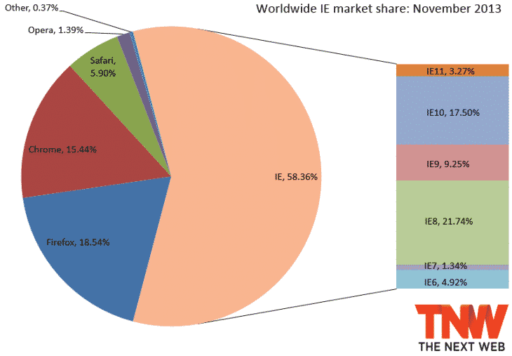Mozilla executives today took shots at Google for pitching its Chrome Frame plug-in as a solution to Internet Explorer’s poor performance, with one arguing that Google’s move will result in “browser soup.”
The Mozilla reaction puts the company that builds Firefox on the same side of the debate as rival Microsoft, which has also blasted Google over the plug-in.
Released last week , Chrome Frame lets Internet Explorer 6 (IE6), IE7 and IE8 utilize the Chrome browser’s WebKit rendering engine, as well as its high-performance V8 JavaScript engine. Google pitched the plug-in as a way to instantly improve the performance of the notoriously slow IE , and as a way for Web developers to support standards IE can’t handle, including HTML 5.
Specifically, said Google, it was pushing Chrome Frame because it decided it wasn’t worth trying to make its new collaboration and communications tool, Google Wave, work with IE. Google developers spent “countless hours” on tweaking Wave for IE, but gave up.
“We could continue in this fashion, but using Google Chrome Frame instead lets us invest all that engineering time in more features for all our users, without leaving Internet Explorer users behind,” argued Lars Rasmussen and Adam Schuck of Google’s Wave team last week.
Mitchell Baker, the former CEO of Mozilla and currently the chairman of the Mozilla Foundation, disagreed with Google’s tactic to slip Chrome inside IE. Strongly.
“The overall effects of Chrome Frame are undesirable,” she said in an entry to her personal blog late Monday. “I predict positive results will not be enduring and — and to the extent it is adopted — Chrome Frame will end in growing fragmentation and loss of control for most of us, including Web developers.”
According to Baker, Chrome Frame’s browser-in-a-browser will confuse users and render some of their familiar tools useless. “Once your browser has fragmented into multiple rendering engines, it’s very hard to manage information across Web sites. Some information will be manageable from the browser you use and some information from Chrome Frame. This defeats one of the most important ways in which a browser can help people manage their [Web] experience.”
But Chrome Frame’s biggest problem, said Baker, is that it cedes control to the site, not the person surfing. And that will just confuse users.
“For many people, Chrome Frame will make the Web even more unknowable and confusing,” Baker said. “Image you download Chrome Frame. You go to a Web site. What rendering engine do you end up using? That depends on the Web site now, not on you.”
Microsoft took a different tack when it slammed Google for releasing Chrome Frame. The plug-in, claimed Microsoft, not only doubles the risk of attack — users have to worry about vulnerabilities in both IE and Chrome — but also breaks several features in its browser, including the private browsing mode.
Mike Shaver, Mozilla’s vice president of engineering, weighed in yesterday alongside Baker, but also gave Google some advice.
“The user’s understanding of the Web’s security model and the behavior of their browser is seriously hindered by delegating the choice of software to the developers of individual sites they visit,” Shaver said. “It is a problem that we have seen repeatedly with other stack plug-ins like Flash, Silverlight and Java, and not one that I think we need to see replayed again under the banner of HTML 5.
“It would be better for the Web if developers who want to use the Chrome Frame snippet simply told users that their site worked better in Chrome, and instructed them on how to install it,” Shaver added.
He also panned Chrome Frame for some of the same reasons as Microsoft, but added several features “bricked” by the plug-in to the list, including IE8’s Accelerators and accessibility tools.
Google’s approach to solving the outdated browser problem is the path to madness, Baker concluded.
“Imagine having the Google browser-within-a-browser for some sites, the Facebook browser-within-a-browser for Facebook Connect sites, the Apple variant for iTunes, the mobile-carrier variant for your mobile sites,” said Baker. “Each browser-within-a-browser variant will have its own feature set, its own quirks, and its own security problems. The result is a sort of browser-soup, where … the Web is less knowable, less understandable and certainly less manageable.”
The Chrome Frame plug-in works with IE6, IE7 and IE8 on Windows XP and Windows Vista. It’s available from Google’s site as a free download .
Google did not immediately reply to a request for a reaction to Mozilla’s criticisms of Chrome Frame.
Source: IT World.com




PC World released a list of the top 10 Google Chrome Add-ons. http://www.pcworld.com/article/185744/top_10_chrome_browser_add_ons.html
Sweet, finally a post that fulfills my research. So many people get this topic wrong. You are a great thinker.
Thanks for your comments. I read it from ITWorld.com & I also write here the source.
It is not my article.